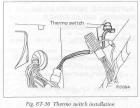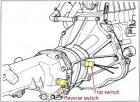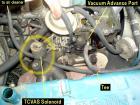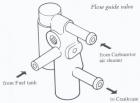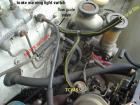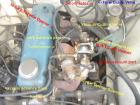Starting with 1972 USA models and 1976 Australian models, Transmission Controlled Vacuum Advance System (TCVAS) disables spark advance except in Top Gear. Since this "retarded" spark timing reduces performance, to prevent cold-engine driving problems this system is bypassed in cold temperatures. This means vacuum advance works normally at cold cabin temperatures.
Contents |
Overview
Vacuum advance in all models uses a hose from the Distributor to the 'port' on the carburetor. In the TCVAS system, there is a valve inserted into the hose to block/allow the vacuum.
The vacuum valve is electrically controlled. With 12V supplied, vacuum is blocked. From a performance standpoint, this is fairly foolproof becuase if a wire is disconnected it works with normal advance. Only when correctly wired does it block vacuum advance.
Note that since Ignition Timing is set with distributor hose disconnected and plugged, a malfunction in the TCVAS will: * not affect the Ignition Timing procedure * not affect idle-speed setting
Components
- Vacuum Hose with special orifice-restriction between carb and tee-connector connected to the vacuum advance hose. This has a precision orifice (jet) in it to control flow of air
- Electrical "Thermo switch" in cabin, under dash mounted high on the right-side kick panel. This is a little round button-shaped unit. It is a simple on/off thermostat which turns "On" as temperature raises past 41-55 degrees. It turns "Off" when temperature falls below 34 degrees
- Electrical "Top Switch" screwed into the side of the transmission (left side, near the bell housing). It is closed in top gear (allowing regular advance), open in all other gears and neutral (disabling advance)
- Electrical 'Vacuum Cutting Valve Solenoid. When energized, it cuts off the vacuum advance
CAUTIONS
- Using a normal hose from the carb to the T-connector results in a small vacuum leak. Only use the special orifice-restricted hose
The thermo switch is located inside the passenger compartment:

Location: Under dash, right side of car
The thermostatic switch:
- Conducts between 41F and 55 F as temperature rises
- Ohmmeter should indicates 0 above 55 degrees
- Disconnects below 34F as temperature falls
- Ohmmeter should indicate infinity (~) below 34 degrees
Tip: To prevent advance cut-out, leave heater off and roll down the windows.
Solenoid Location: just aft of carbuetor, bolted to the intake manifold.

It is the cylinder on the right (with green wire), seen just below the throttle opener
Schematic
Both vacuum and electricity are used.
In cold weather, vacuum advance is normal Until car warms up...
- Reverse lights switch
- Top switch (emission controlled models)
When current flows to the Vacuum Cutting Solenoid, it cuts the vacuum advance.
If the Solenoid is disconnected, vacuum advance works normally.
The Top Switch is normally open (allowing current). Only in top gear (4th) does it become electrically closed.
If you neglect to connect the top switch, vacuum advance works normally.
So this is nearly a foolproof system. If any electrical component goes bad or is not connected, normal operation occurs. Only when every electric circuit is working does it cut vacuum advance.
Vacuum Hoses
Vacuum advance in all models uses a hose from the Distributor to the 'port' on the carburetor. TCVAS adds to this, by adding a 'T" line. The 'T' carries vacuum to the Vacuum Cutting Valve Solenoid, which when electrically powered, dumps the vacuum through a small orifice connected to air. This effectively 'cuts' vacuum advance, while the small orifice prevents a vacuum leak.
The source of air to the Valve is both:

![[Datsun 1200 encyclopedia]](/wiki/upload/wiki.png)
